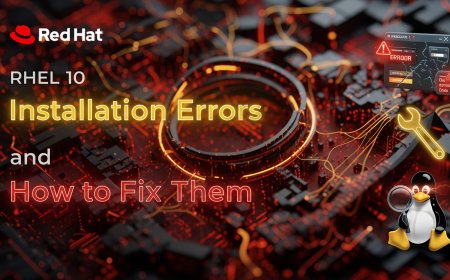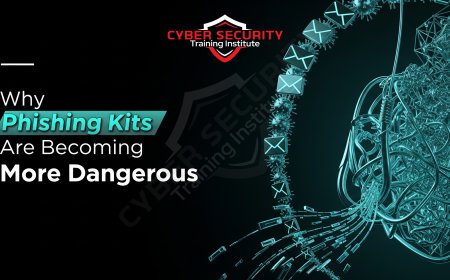RHEL 10 Training Online vs Offline: What’s Better?
Choosing the right training format is a critical first step on your journey to mastering Red Hat Enterprise Linux and achieving a valuable certification. This in-depth guide provides a comprehensive and balanced comparison of the two primary learning models: traditional, offline classroom training versus modern, flexible online training. We break down the key advantages and disadvantages of each approach, helping you understand the important trade-offs. Discover the power of the immersive, structured environment and direct instructor access that a classroom provides, and weigh it against the unmatched flexibility, affordability, and repeatability of an online course. The piece features a detailed comparative analysis that directly contrasts the two formats across a range of crucial factors, including cost, instructor interaction, networking opportunities, and the level of self-discipline required. We also explore the rise of popular hybrid models, like live virtual training, that combine the best of both worlds. This is an essential read for any aspiring Linux professional trying to decide which RHEL training path best aligns with their personal learning style, budget, and career goals.
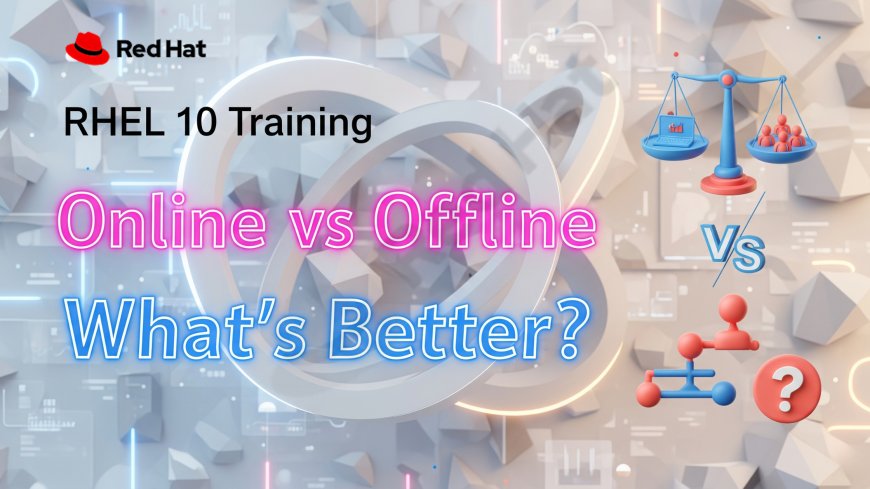
Introduction: Choosing Your Learning Path
You've decided to invest in your career by mastering Red Hat Enterprise Linux, the world's leading enterprise Linux platform. That's a fantastic choice. But now you face another critical decision that will have a huge impact on your learning journey: should you enroll in a traditional, offline classroom training, or should you embrace the flexibility and affordability of an online course? In today's world, the choice is no longer as simple as it used to be. Both methods have evolved and now offer powerful and distinct advantages. The best choice isn't about which one is universally "better," but about which one best aligns with your personal learning style, your budget, your professional schedule, and your career goals. This guide will take a deep, balanced dive into both online and offline RHEL training formats to help you make the right decision.
The Case for Offline (Classroom) Training
The traditional, instructor-led classroom training (ILT) model is the classic way to learn a new, complex technology, and it offers several powerful benefits that are hard to replicate online.
- A Structured, Immersive Environment: The biggest advantage of a classroom is the environment itself. For a full week, you are in a dedicated learning space, completely immersed in the material and free from the constant distractions of the office or your home. The fixed, structured schedule enforces a level of discipline and focus that can be difficult to achieve on your own.
- Direct, Real-Time Instructor Access: This is the key benefit. You have a certified Red Hat instructor, a subject matter expert, in the room with you. You can ask a question the moment it pops into your head, get immediate clarification on a complex topic, and benefit from the instructor's valuable, real-world experience and anecdotes. This instant feedback loop is incredibly powerful.
- Peer-to-Peer Learning and Networking: In a classroom, you are learning alongside a cohort of other IT professionals from different companies and backgrounds. This provides an invaluable opportunity for peer-to-peer learning. You can learn from the questions your classmates ask, work together on complex problems, and build your professional network.
- Instant Help with Hands-On Labs: While both formats have hands-on labs, in a classroom, if you get stuck on a difficult lab exercise, you can simply raise your hand. The instructor can walk over to your desk, look at your screen, and instantly help you get unstuck.
The Case for Online Training
Online training has exploded in popularity for a reason. It offers a level of flexibility and accessibility that is simply impossible for the traditional classroom model to match.
- Unmatched Flexibility: This is the number one advantage. With a self-paced online course, you can learn whenever and wherever you want. You can study late at night after the kids are in bed, on the weekends, or during your lunch break. You don't have to take a full week off from your job to attend a class. This allows you to fit your learning around your existing personal and professional commitments.
- Significant Cost-Effectiveness: Online training is almost always significantly cheaper than its offline counterpart. Not only is the course fee itself often lower, but you also save completely on the secondary costs of travel, hotels, and meals that are often required for attending an in-person class in a major city.
- The Power to Repeat and Review: In a live class, if the instructor explains a complex topic and you don't quite get it, the class moves on. With an online video-based course, you can pause, rewind, and re-watch a lecture as many times as you need to until you have fully mastered the concept. This ability to review is a massive learning advantage.
- A Wide Variety of Formats: Online training isn't just one thing. It can be a fully self-paced course with pre-recorded videos, a live "virtual classroom" that offers real-time instruction online, or a subscription-based platform like the Red Hat Learning Subscription that gives you access to a vast library of courses.
Who Is Each Method For? Finding Your Fit
The best format for you depends heavily on your learning style, experience level, and personal circumstances.
Offline (Classroom) Training is likely a great fit for you if:
- You are a beginner or are new to the subject and would benefit from a highly structured, guided, and immersive learning environment.
- You learn best through direct, interactive conversation, and you value the ability to ask questions and get immediate feedback from a live expert.
- Your company is sponsoring your training and can afford both the higher cost of the course and the time you will need to be away from your daily work.
Online Training is likely a great fit for you if:
- You are a self-motivated and highly disciplined learner who can create and stick to your own study schedule without external pressure.
- You are an experienced IT professional who is just looking to upskill on a new version or a specific technology and you don't need a full, instructor-led introductory course.
- You are on a tighter budget or you have personal or professional commitments that make it impossible for you to take a full week off for a classroom course.
.
Comparative Analysis: Online vs. Offline Training Factors
The choice between online and offline training involves a series of trade-offs between flexibility, cost, interaction, and the level of discipline required.
| Factor | Online Training | Offline (Classroom) Training |
|---|---|---|
| Flexibility & Scheduling | Extremely high. It allows you to learn anytime, anywhere, and completely at your own pace. | Very low. It requires you to be in a specific physical location at a specific time for a fixed, multi-day duration. |
| Total Cost | Is generally the lower-cost option. The course fees are often less, and there are no travel or accommodation expenses. | Is generally the higher-cost option, as it includes the price of the course plus the potential costs of travel, hotels, and meals. |
| Instructor Interaction | Is often asynchronous (via forums or email) or is limited to scheduled sessions in a live virtual classroom. | Is direct, immediate, and continuous. The instructor is physically in the room with you to answer questions and provide help instantly. |
| Networking Opportunities | Is generally limited to online forums or community chat channels. | Is excellent. It provides valuable, face-to-face networking opportunities with a peer group of other local professionals in your field. |
| Discipline Required | Requires a very high level of self-discipline and personal motivation to stay on track and complete the course. | The structured schedule and the immersive classroom environment naturally enforce discipline and keep you focused. |
| Content Review & Repetition | Is excellent. You have the ability to re-watch video lectures and review materials as many times as you need to master a concept. | Is limited. It relies heavily on your own notes. You cannot "rewind" a live instructor if you miss a key point. |
The Best of Both Worlds: The Rise of the Hybrid Model
The good news is that in today's world, you don't always have to make a binary choice between these two extremes. A number of popular hybrid models have emerged that try to combine the best features of both formats.
The most common of these is Live Virtual Training. In this model, you are attending a live, instructor-led class, but you are doing it remotely from your own home or office via a video conferencing platform. This model gives you the direct, real-time access to an expert instructor that is the hallmark of classroom training, but with the convenience and cost savings of not having to travel. Another popular "blended learning" model involves doing the theoretical learning through self-paced online videos and then attending a shorter, one or two-day, in-person session that is focused entirely on intensive, instructor-led, hands-on lab work. As you evaluate your options, be sure to look for these hybrid models that might offer the perfect balance for your needs.
Conclusion: The Right Choice is a Personal One
The debate between online and offline RHEL training isn't about finding the single, objectively "best" method. The truth is that both formats can be incredibly effective. The real task is to find the best method for you. Online training offers a world of flexibility and affordability, making it more accessible to more people than ever before. Offline, classroom-based training offers a level of structure, immersion, and direct human interaction that is still hard to beat for many learners. The key to success, regardless of the format you choose, remains the same: a deep, personal commitment to performing the intensive, hands-on practice in a real lab environment that is necessary to build real-world skills. Take the time to honestly assess your own learning style, your budget, and your schedule, and then choose the path that will best equip you with the practical, hands-on skills you need to get certified and to take the next step in your career.
Frequently Asked Questions
What is RHEL?
RHEL stands for Red Hat Enterprise Linux. It is a commercial Linux distribution that is widely used in enterprise data centers and cloud environments due to its stability and long-term support.
What is the RHCSA certification?
The RHCSA (Red Hat Certified System Administrator) is the foundational, performance-based certification that validates your core skills in administering RHEL systems.
Is online training as good as offline training?
It can be, but it depends on the learner. For a self-motivated, disciplined individual, a high-quality online course can be just as effective, if not more so, than a classroom course. For a beginner who needs more guidance, the classroom might be better.
What is a "virtual classroom"?
A virtual classroom is a live, instructor-led training class that is conducted entirely online using video conferencing and remote lab environments. It is a popular hybrid training model.
Can I get a job with just an online certificate?
The certificate of completion from an online course is not the same as a formal certification. The real goal is to use the online course to gain the skills you need to pass the official, performance-based certification exam, like the RHCSA.
How important are the hands-on labs?
They are the single most important part of the training. Red Hat exams are 100% practical. You cannot pass by just watching videos; you must spend many hours practicing the commands and tasks in a real lab environment.
What is a Red Hat Learning Subscription?
It is a subscription service from Red Hat that provides a year of access to their entire library of self-paced online courses, video lectures, and cloud-based lab environments.
Is classroom training very expensive?
It is generally the most expensive option. The course fee itself is often higher, and you also have to factor in the potential costs of travel and accommodation if the class is not in your city.
What is a "self-paced" course?
A self-paced course is a type of online learning where there is no live instructor or fixed schedule. You are given access to all the course materials (like videos and labs) and you can work through them at whatever speed you like.
What does ILT stand for?
ILT stands for Instructor-Led Training. It is the formal name for the traditional, in-person, classroom-based training model.
Can I ask questions in an online course?
It depends on the format. In a self-paced course, you can typically ask questions in a student forum or via email, but the response will not be immediate. In a live virtual classroom, you can ask questions in real-time, just like in a physical classroom.
Do I get access to a lab with online training?
Yes, all reputable online training providers, including Red Hat's own platform, will provide you with access to a cloud-based, hands-on lab environment where you can practice the course exercises.
What is the main advantage of offline training?
The main advantage is the immediate, direct access to an expert instructor who can answer your questions, provide personalized feedback, and help you the moment you get stuck on a difficult topic.
What is the main advantage of online training?
The main advantage is its flexibility. It allows you to learn at your own pace and on your own schedule, which makes it possible to get trained without having to take time off from work or disrupt your family life.
What is a "hybrid" training model?
A hybrid or "blended" model is one that combines elements of both online and offline training, such as a live virtual classroom or a course that combines self-paced online learning with a short, in-person lab session.
Which format is better for networking?
Offline, classroom-based training is far better for networking. It provides a valuable opportunity to build professional connections with your instructor and with the other IT professionals in the class.
How do I know which learning style is best for me?
You should honestly assess how you have learned best in the past. Are you a disciplined self-starter who is comfortable learning from books and videos? Or do you learn best in a structured, interactive environment where you can ask a lot of questions?
Does my company's location matter for training?
For offline training, yes, as you will need to travel to a city that has an authorized training center. For online training, your location does not matter at all.
Do both formats prepare you for the same exam?
Yes, both a reputable online course and an official offline course are designed to teach you the skills and knowledge you need to pass the same official Red Hat certification exam.
What is the most important factor for success?
Regardless of the format you choose, the single most important factor for success is the amount of time you spend doing the hands-on lab exercises. Practical, muscle-memory skill is what the exam tests for.
What's Your Reaction?
 Like
0
Like
0
 Dislike
0
Dislike
0
 Love
0
Love
0
 Funny
0
Funny
0
 Angry
0
Angry
0
 Sad
0
Sad
0
 Wow
0
Wow
0







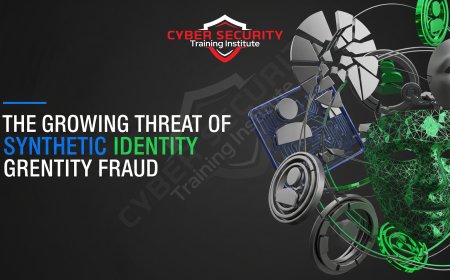
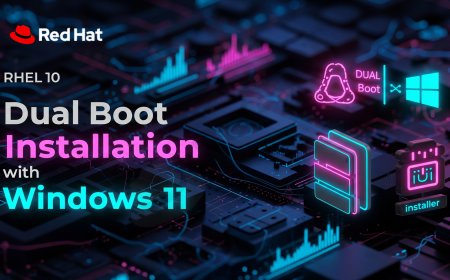
![How to Install RHEL 10 on VMware/VirtualBox [Tutorial]](https://www.cybersecurityinstitute.in/blog/uploads/images/202509/image_430x256_68b56dc967a4a.jpg)
